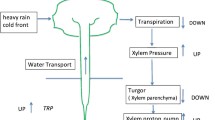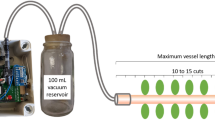Abstract
Diurnal changes of xylem pressure in the lianaTetrastigma voinierianum have been measured under greenhouse conditions by means of the recently developed xylem pressure probe. During the early morning hours, tensions in the vessels developed more or less rapidly with time, depending on light intensity. On sunny days, absolute negative pressures down to about -0.4 MPa (atmospheric = 0.1 MPa) were recorded around noon in petiolar or stem xylem vessels, whereas on rainy or cloudy days the xylem pressure remained in the positive sub-atmospheric or slightly negative pressure range. Towards the evening the tension in the vessels always decreased, i.e. the xylem pressure shifted to about atmospheric, or even above-atmospheric, values during the night. Simultaneous xylem pressure recordings at heights of 1 and 5 m frequently yielded either no gradient in tension at all, or far less than expected from the Cohesion Theory. Occasionally, tension gradients were even opposite to those predicted by this theory. Stem-toleaves pressure gradients in accord with the Cohesion Theory were recorded only when tension had been developed during sunny days in the upper branches of the liana, because increases in tension were not immediately propagated to the xylem of the leaves at ground level, as would be expected from a strictly coupled hydraulic system. Parallel recordings of the “xylem tension” using the pressure chamber yielded rather variable values ranging from 0.1 to 1 MPa; diurnal pressure changes could not be detected at all. The data are discussed on the basis of the equation for the chemical activity of water. They strongly suggest that the xylem tension induced by transpiration is not the sole force for water ascent. Other forces, such as osmotic pressure or convectional and interfacial forces, which to a remarkable extent have already been postulated for decades, seem to be equally important.
Similar content being viewed by others
Abbreviations
- R.H.:
-
relative humidity
References
Amin M (1982) Ascent of sap in plants by means of electrical double layers. J Biol Phys10: 103–109
Andrews FC (1976) Colligative properties of simple solutions. Solutes simply dilute the solvent; they do not cause tension in the solvent. Science194: 567–571
Askenasy E (1895) Über das Saftsteigen. Verhandl Naturhist Med Ver Heidelberg, NF5: 325–345
Balling A, Zimmermann U (1990) Comparative measurements of the xylem pressure ofNicotiana plants by means of the pressure bomb and probe. Planta182: 325–338
Balling A, Zimmermann U, Büchner K-H, Lange OL (1988) Direct measurement of negative pressure in artificial-biological systems. Naturwissenschaften75: 409–411
Baughn JW, Tanner CB (1976a) Leaf water potential: Comparison of pressure chamber and in situ hygrometer on five herbaceous species. Crop Sci16: 181–184
Baughn JW, Tanner CB (1976b) Excision effects on leaf water potential of five herbaceous species. Crop Sci16: 184–190
Benkert R, Balling A, Zimmermann U (1991) Direct measurements of the pressure and flow in the xylem vessels ofNicotiana tabacum and their dependence on flow resistance and transpiration rate. Bot Acta104: 423–432
Böhm J (1893) Capillarität und Saftsteigen. Ber Dtsch Bot Ges11: 203–212
Boucherie A (1840) Rapport sur un mémoire de M. le docteur Boucherie relatif à la conversation des bois. Compt Rend11: 894–898
Braun HJ (1983) Zur Dynamik des Wassertransportes in Bäumen. Ber Dtsch Bot Ges96: 29–47
Braun HJ (1984) The significance of the accessory tissues of the hydrosystem for osmotic water shifting as the second principle of water ascent, with some thoughts concerning the evolution of trees. IAWA Bull5: 275–294
Canny MJ (1990) What becomes of the transpiration stream? New Phytol114: 341–368
Canny MJ (1993) The transpiration stream in the leaf apoplast: Water and solutes. Philos Trans R Soc London Ser B341: 87–100
Copeland EB (1902) The rise of the transpiration stream. An historical and critical discussion. Bot Gaz34: 260–283
Dixon HH (1914) Transpiration and the ascent of sap in plants. Macmillan and Co., Ltd., London
Dixon HH, Joly J (1894) On the ascent of sap. Philos Trans R Soc London Ser B186: 563–576
Goldstein G, Nobel PS (1991) Changes in osmotic pressure and mucilage during low temperature acclimation ofOpuntia ficus-indica. Plant Physiol97: 954–961
Goldstein G, Andrade JL, Nobel PS (1991) Differences in water relations parameters for the chlorenchyma and the parenchyma ofOpuntia ficus-indica under wet versus dry conditions. Aust J Plant Physiol18: 95–107
Grace J (1993) Consequences of xylem cavitation for plant water deficits. In: Smith JAC, Griffiths H (eds) Water deficits: Plant responses from cell to community. Bios Scientific Publishers, Oxford, pp 109–128
Greenidge KNH (1957) Ascent of sap. Annu Rev Plant Physiol8: 237–256
Hammel HT (1973) On the ascent of sap (letter to the editor). Science179: 1248–1249
Huber B, Schmidt E (1936) Weitere thermo-elektrische Untersuchungen über den Transpirationsstrom der Bäume. Tharandt Forst Jb87: 369–412
Jacobsen KR, Fisher DG, Maretzki A, Moore PH (1992) Developmental changes in the anatomy of the sugarcane stem in relation to phloem unloading and sucrose storage. Bot Acta105: 70–80
Kappen L, Lange OL, Schulze ED, Evenari M, Buschbom U (1972) Extreme water stress and photosynthetic activity of the desert plantArtemisia herba-alba Asso. Oecologia (Berlin)10: 177–182
Köckenberger W, Pope J, Callaghan PT, Komor E (1994) The water flow within the castor bean seedling: A theoretical model confirmed by non-invasive NMR-imaging. Abstr Botanikertagung Bayreuth, p 161
Kramer PJ (1983) Water relations of plants. Academic Press, New York London San Diego
Kuchenbrod E, Deichmann R, Thürmer F, Zimmermann U, Haase A (1994) Imaging of very slow flow with NMR: Application to plant systems. Abstr Botanikertagung Bayreuth, p 160
Kurtzman RH Jr (1966) Xylem sap flow as affected by metabolic inhibitors and girdling. Plant Physiol41: 641–646
Langbein D, Heide W (1986) Study of convective mechanisms under microgravity conditions. Adv Space Res6: 5–17
Loik ME, Nobel PS (1991) Water relations and mucopolysaccharide increases for a winter hardy cactus during acclimation to subzero temperatures. Oecologia88: 340–346
Mauro A (1965) Osmotic flow in a rigid porous membrane. Science149: 867–869
Molisch H (1898) Über das Bluten tropischer Holzgewächse im Zustand völliger Belaubung. Ann Jard Bot Buitenzorg2: Suppl, 23–32
Morse SR (1990) Water balance inHemizonia luzulifolia: the role of extracellular polysaccharides. Plant Cell Environ13: 39–48
Murphy R, Smith JAC (1994) A critical comparison of the pressure-probe and pressure-chamber techniques for estimating leaf-cell turgor pressure inKalanchoe daigremontiana. Plant Cell Environ17: 15–29
Passioura JB, Munns R (1984) Hydraulic resistance of plants II. Effects of rooting medium, and time of day, in barley and lupin. Austr J Plant Physiol11: 341–350
Pickard WF (1981) The ascent of sap in plants. Prog Biophys Molec Biol37: 181–229
Plumb RC, Bridgman WB (1972) Ascent of sap in trees. Science176: 1129–1131
Preston RD (1952) Movement of water in higher plants. In: Frey-yssling A (ed) Deformation and flow in biological systems. North Holland Publishing Co., Amsterdam, pp 257–321
Renner O (1925) Zum Nachweis negativer Drucke im Gefäßwasser bewurzelter Holzgewächse. Flora119: 402–408
Richter HH (1973) On the ascent of sap (letter to the editor). Science179: 1249
Sachs J (1887) Vorlesungen über Pflanzen-Physiologie. Verlag Wilhelm Engelmann, Leipzig
Scholander PF (1973) On the ascent of sap (letter to the editor). Science179: 1248
Scholander PF, Love WE, Kanwisher JW (1955) The rise of sap in tall grapevines. Plant Physiol30: 93–104
Scholander PF, Hammel HT, Bradstreet ED, Hemmingsen EA (1965) Sap pressure in vascular plants. Science148: 339–346
Schulte PJ (1993) Tissue hydraulic properties and the water relations of desert shrubs. In: Smith JAC, Griffiths H (eds) Water deficits: Plant responses from cell to community. Bios Scientific Publishers, Oxford, pp 177–192
Schwenke H, Wagner E (1992) A new concept of root exudation. Plant Cell Environ15: 289–299
Smith AM (1991) Negative pressure generated by octopus suckers: a study of the tensile strength of water in nature. J Exp Biol157: 257–271
Smith AM (1994) The cohesive strength of water and xylem transport. Ann Bot74: 647–651
Smith JAC, Lüttge U (1985) Day-night changes in leaf water relations associated with the rhythm of crassulacean acid metabolism inKalanchoe daigremontiana. Planta163: 272–282
Spanner DC (1951) The Peltier effect and its use in the measurement of suction pressure. J Exp Bot2: 145–168
Strasburger E (1891) Über den Bau und die Verrichtungen der Leitungsbahnen in den Pflanzen. G Fischer, Jena
Tanner W, Beevers H (1990) Does transpiration have an essential function in long distance ion transport in plants? Plant Cell Environ13: 745–750
Tyree MT, Sperry JS (1989) Vulnerability of xylem to cavitation and embolism. Annu Rev Plant Physiol40: 19–38
Von Faber FG (1915) Physiologische Fragmente aus einem tropischen Urwald. Jahrb Wiss Bot56: 197–220
Von Guttenberg H (1956) Lehrbuch der Allgemeinen Botanik. 5. Edn, Akademie Verlag Berlin
Welbaum GE, Meinzer FC, Grayson RL, Thornham KT (1992) Evidence for and consequences of a barrier to solute diffusion between the apoplast and vascular bundles in sugarcane stalk tissue. Austr J Plant Physiol19: 611–624
Young NO, Goldstein JS, Block MJ (1959) The motion of bubbles in a vertical temperature gradient. J Fluid Mech6: 350–356
Yount DE (1979) Growth of bubbles from nuclei. In: Brubakk AO, Hemmingsen BB, Sundnes G (eds) Supersaturation and bubble formation in fluids and organisms. The Royal Norwegian Society of Sciences and Letters, The Foundation, pp 131–164
Yount DE, Kunkle TD, D'Arrigo JS, Ingle FW, Yeung CM, Beckman EL (1977) Stabilization of gas cavitation nuclei by surface-active compounds. Aviation Space Environ Med48: 185–191
Yount DE, Yeung CM, Ingle FW (1979) Determination of the radii of gas cavitation nuclei by filtering gelatin. J Acoust Soc Am65: 1440–1450
Yount DE, Gillary EW, Hoffmann DC (1984) A microscopic investigation of bubble formation nuclei. J Acoust Soc Am76: 1511–1521
Zhu JJ, Zimmermann U, Thürmer F, Kuchenbrod E, Haase A (1995) Xylem pressure response in maize roots subjected to osmotic stress: determination of radial reflection coefficients by use of the xylem pressure probe. Plant Cell Environ in press
Ziegler H (1977) Flüssigkeitsströme in Pflanzen. In: Hoppe W, Lohmann W, Markl H, Ziegler H (eds) Biophysik. Springer-Verlag Berlin Heidelberg New York, pp 561–577
Zimmermann MH (1983) Xylem structure and the ascent of sap. Springer-Verlag Berlin Heidelberg New York Tokyo
Zimmermann MH, Brown C (1980) Trees, Structure and Function, Springer-Verlag Berlin Heidelberg New York Tokyo
Zimmermann U, Balling A (1989) Comparative measurements of the xylem pressure ofNicotiana plants by means of the pressure bomb and probe. In: Dainty J, de Michelis MI, Marr E, Rasia-Caldogno F (eds) Plant membrane transport: The current position. Elsevier, Amsterdam New York Oxford, pp 555–558
Zimmermann U, Benkert R, Schneider H, Rygol J, Zhu JJ, Zimmermann G (1993a) Xylem pressure and transport in higher plants and tall trees. In: Smith JAC, Griffiths H (eds) Water deficits: Plant responses from cell to community. Bios Scientific Publishers, Oxford, pp 87–108
Zimmermann U, Haase A, Langbein D, Meinzer FC (1993b) Mechanisms of long-distance water transport in plants: a reexamination of some paradigms in the light of new evidence. Philos Trans R Soc London Ser B341: 19–31
Zimmermann U, Meinzer FC, Benkert R, Zhu JJ, Schneider H, Goldstein G, Kuchenbrod E, Haase A (1994a) Xylem water transport: Is the available evidence consistent with the cohesion theory? Plant Cell Environ17: 1169–1181
Zimmermann U, Zhu JJ, Meinzer FC, Goldstein G, Schneider H, Zimmermann G, Benkert R, Thürmer F, Melcher P, Webb D, Haase A (1994b) High molecular weight organic compounds in the xylem sap of mangroves: Implications for long-distance water transport. Bot Acta107: 218–229
Author information
Authors and Affiliations
Corresponding author
Additional information
The authors are very grateful to Professor D. Fürnkranz, Institut für Botanik der Universität Salzburg, for his interest and help with the greenhouse facility, to Walter Gigerl for expert technical assistance, to Heike Schneider and Notburga Gierlinger for the petiolestaining experiments. This work was supported by a grant of the Deutsche Forschungsgemeinschaft to U.Z. (NMR-Graduiertenkolleg Ha 1232/8-1).
Rights and permissions
About this article
Cite this article
Benkert, R., Zhu, JJ., Zimmermann, G. et al. Long-term xylem pressure measurements in the lianaTetrastigma voinierianum by means of the xylem pressure probe. Planta 196, 804–813 (1995). https://doi.org/10.1007/BF01106777
Received:
Accepted:
Issue Date:
DOI: https://doi.org/10.1007/BF01106777




